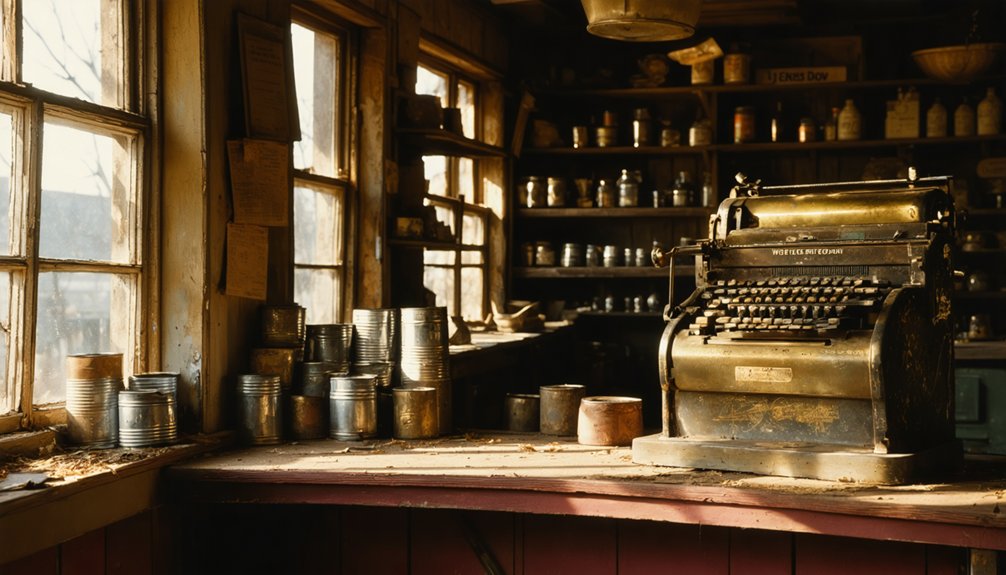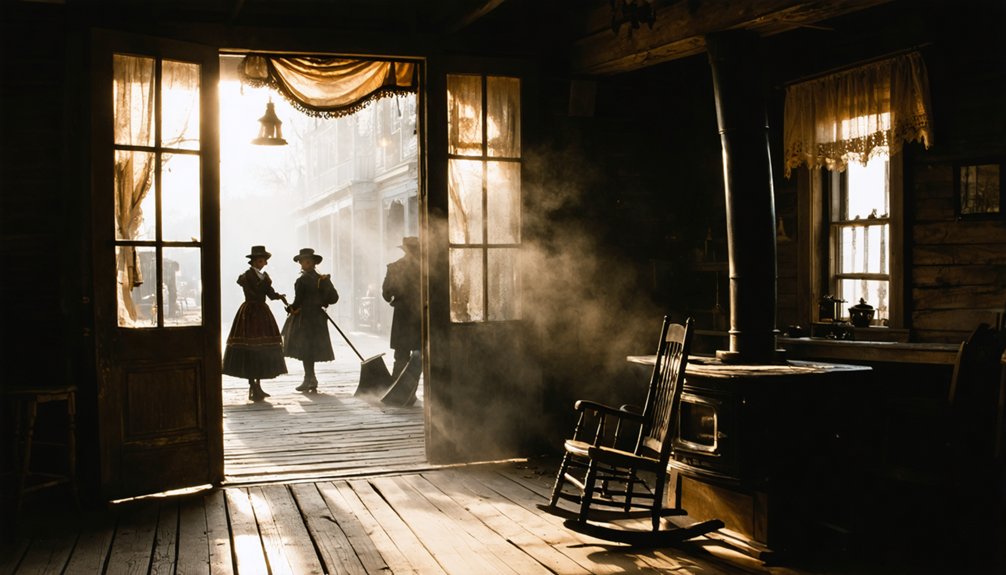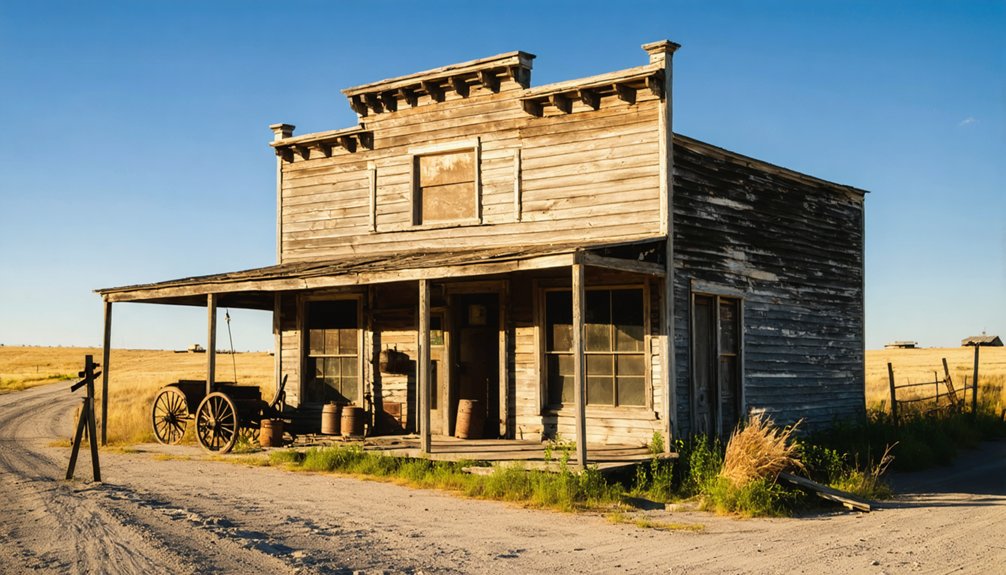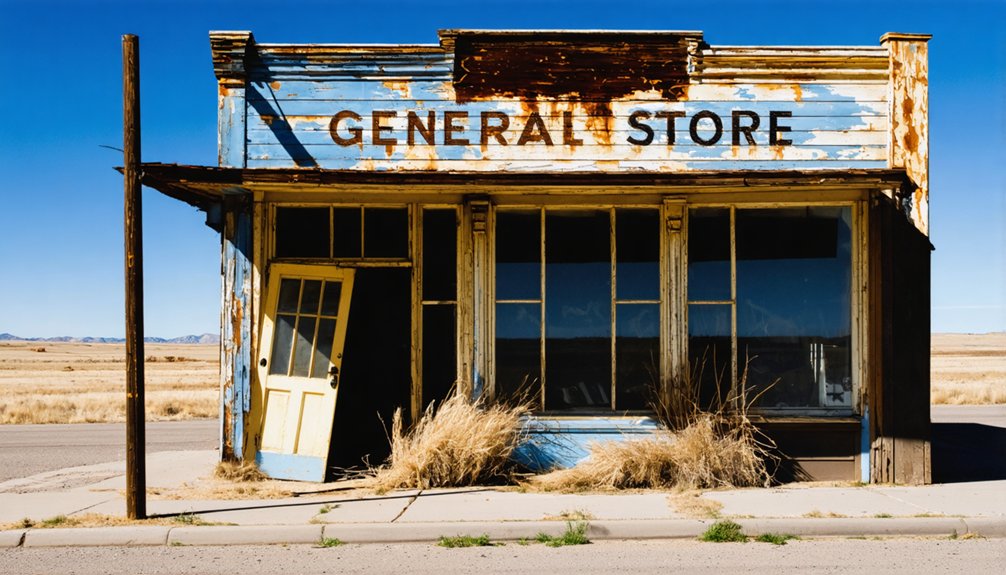You’ll discover the abandoned mining settlement of Volunteer tucked away in South Dakota’s Black Hills, where weathered buildings stand as silent witnesses to the 1876 gold rush era. The town flourished when over 15,000 prospectors flocked to the region, establishing more than 1,000 mines throughout Lawrence and Pennington counties. Today, you can explore the remnants of stamp mills, cyanide vats, and original structures that tell a compelling story of frontier ambition and determination.
Key Takeaways
- Volunteer was a mining boomtown in South Dakota established during the 1870s gold rush that later became a ghost town.
- The town’s empty streets and deteriorating structures serve as physical remnants of its mining heritage.
- Cyanide vats, mill foundations, and ore processing remnants can still be found throughout the abandoned town site.
- Families left Volunteer when mines became unprofitable, leading to the community’s eventual abandonment and ghost town status.
- The town’s remains demonstrate the boom-and-bust cycle typical of Black Hills mining communities during the late 19th century.
The Hidden Treasure of the Black Hills
Five distinct natural wonders define the majestic Black Hills, each offering a unique glimpse into South Dakota’s untamed beauty.
You’ll discover the pristine Sylvan Lake nestled among granite peaks, and witness herds of bison roaming freely along Wildlife Loop Road. As you venture deeper, hidden caves and forgotten legends await your exploration, from the mysterious Community Caves Trail to the serene paths of Blue Bell Lodge. The $25 park pass grants you access to these remarkable sights for a full week of adventure. The Lakota tribe first inhabited these sacred lands, giving the region its name Paha Sapa.
The region’s treasures extend beyond its surface beauty. Tales of General Custer’s hidden rifles near Castle Creek and abandoned mines holding placer gold near Pactola Dam spark the imagination.
You’ll find yourself drawn to ghost towns scattered around Custer Peak, where pioneer relics tell stories of early settlers who once called these rugged hills home.
A Mining Community’s Rise and Fall
You’ll find Silver City’s story began in 1876 when the Gorman brothers chased their dreams of gold and silver riches in South Dakota’s Black Hills.
During its peak years, this bustling community of over 300 residents supported a general store, hotel, sawmill, and church, while its miners split time between local claims and wages from the nearby Homestake Mine.
The arrival of the Crouch Line railroad in 1906 helped connect the town to outside markets and communities.
Today, you can walk the quiet streets lined with century-old buildings, where abandoned mines and weathered structures stand as silent witnesses to the town’s brief but vibrant mining era. The area’s rich heritage is preserved through volunteer tour guides who share stories of the region’s mining history.
Gold Rush Dreams Begin
The dreams of striking it rich began in 1874 when gold was discovered near French Creek in the Black Hills, sparking one of America’s last great gold rushes.
You’d have found yourself among 15,000 hopeful prospectors who flooded the region by 1876, armed with pans and determination to strike the mother lode.
As you’d have worked the streams and gulches using placer mining techniques, you might’ve heard whispers of bigger discoveries northward.
The real excitement came when prospectors found the Homestake outcropping near Lead in April 1876.
This discovery would transform the Black Hills forever, shifting from simple placer mining to sophisticated hard rock operations.
While many claims played out quickly, the Homestake’s rich veins promised lasting prosperity, drawing thousands more dreamers to these gold-laden hills.
The region would become home to over 1,000 mines, as prospectors established claims throughout Lawrence and Pennington counties.
By 1875, even though US Army patrols attempted to remove them, thousands of illegal prospectors had already established themselves in the area.
Boom Years Shape Community
Once gold fever gripped the Black Hills in the mid-1870s, sleepy wilderness areas transformed into vibrant boomtowns practically overnight.
You’d have witnessed mining innovations revolutionizing the landscape as stamp mills and hard rock mining techniques increased productivity, while railroads connected these bustling communities to essential supply chains.
These boom years brought remarkable community resilience as diverse populations of miners, merchants, and entrepreneurs built their dreams together. Historic towns like Galena Road hosted vibrant mining settlements during this period.
You’d have found a rich tapestry of social life emerging through schools, theaters, and dance halls, even as residents faced challenges like overcrowding and occasional lawlessness.
Mining companies like Homestake developed sophisticated operations, creating jobs and establishing infrastructure that sustained growth.
The combination of technological advancement and human determination shaped these communities, turning remote wilderness into thriving economic centers of the American West.
The discovery of gold during the Custer Expedition of 1874 sparked widespread interest in the region’s mineral wealth.
Empty Streets Tell Tales
Abandoned mining towns across the Black Hills tell poignant stories of economic collapse and community dissolution.
As you walk Volunteer’s empty streets today, ghostly whispers of its mining past echo through deteriorating wooden structures and scattered mine waste piles. You’ll find the silent histories etched in the landscape – enormous cyanide vats, crumbling mill foundations, and the remnants of ore processing operations that once drove the town’s prosperity. Like over six hundred similar ghost towns scattered throughout the Black Hills region, Volunteer stands as a testament to forgotten dreams. The area provides excellent hiking opportunities while exploring these historic ruins.
When the mines became unprofitable, families dispersed in search of new opportunities, leaving behind their homes and dreams.
The social fabric unraveled as schools closed and community services ceased. What remains are the physical scars of industrial ambition – eroded tailings, abandoned shafts, and the weathered bones of a once-thriving mining community that couldn’t survive the boom-bust cycle.
Standing the Test of Time
While countless mining towns have vanished into history, Galena, South Dakota stands resilient against time’s relentless march. Through community resilience and historical storytelling, you’ll find dedicated volunteers working tirelessly to preserve what remains of this 1870s mining settlement.
You’ll notice the town’s surviving structures face constant challenges from South Dakota’s unforgiving climate. Harsh winters and freeze-thaw cycles threaten the remaining buildings, while persistent vegetation and erosion slowly reclaim the historic sites.
Yet local preservation groups won’t let Galena fade away. They’re stabilizing foundations, maintaining trails, and installing informative signage. Through annual ghost town walks and documentary screenings, they’re keeping Galena’s spirit alive, ensuring that future generations can experience this representation of America’s mining heritage.
Preserving Galena’s Legacy Today

You’ll find remarkable preservation efforts in Galena, where dedicated volunteers from the Historical Society work tirelessly to protect and restore historic structures like the 1882 schoolhouse.
Each year, up to 800 visitors participate in the Ghost Town Walk, raising vital funds through tax-deductible donations and event proceeds that directly support building maintenance and cultural programs.
Through careful documentation and authentic restoration techniques, the community guarantees these living pieces of Old West history will continue to educate and inspire future generations.
Community-Led Restoration Projects
Three dedicated organizations spearhead the preservation of Galena’s historic legacy today, with the Galena Historical Society leading the charge.
You’ll find passionate volunteers coordinating restoration work, organizing educational programs, and maintaining the historic structures that define this remarkable ghost town. The South Dakota Humanities Council provides essential grant funding for documentary projects that capture Galena’s rich history.
Community involvement shapes every preservation strategy, from the annual Ghost Town Walk fundraiser to hands-on restoration projects.
You can witness this grassroots effort in action as volunteers stabilize the old schoolhouse, install interpretive markers, and guide visitors through the alpine creek landscape.
While funding relies primarily on modest donations and grants, the town’s community-led approach guarantees its survival as a premier heritage destination in the American West.
Annual Heritage Events
Each June, the Galena Ghost Town Walk transforms this historic mining settlement into a vibrant heritage celebration, drawing history enthusiasts from across the Black Hills region.
You’ll explore one to five miles of self-guided trails while local speakers share compelling narratives about the town’s mining legacy. The historic schoolhouse opens its doors, offering glimpses into early 1900s education, while documentary screenings and live music create an immersive experience.
Your $5 donation supports crucial heritage preservation through the Galena Historical Society, funding restoration of mining cabins and historic structures.
Through engaging community storytelling, you’ll discover tales of early settlers, notable residents like Thomas Francis Walsh, and the fascinating legends that shaped this remarkable ghost town. Local descendants and historians bring the past to life through personal accounts and cultural traditions.
Historic Building Protection Methods
While time and nature constantly threaten Galena’s historic structures, dedicated preservation efforts ascertain these architectural treasures endure for future generations.
You’ll find historic preservation specialists employing proven techniques like structural bracing, roof repairs, and foundation stabilization to protect these irreplaceable buildings. They’re using period-accurate materials, from reclaimed timber to hand-forged nails, maintaining authenticity in every building restoration project.
Regular monitoring helps catch problems early, while detailed documentation through photos, maps, and oral histories creates a lasting record of Galena’s architectural heritage.
The Galena Historical Society coordinates volunteers for ongoing maintenance, partners with universities for technical expertise, and pursues grants to fund critical preservation work.
Well-maintained trails and controlled vegetation ascertain visitors can safely explore while protecting these historic sites.
Walking Through History: Annual Ghost Town Events

As visitors meander through the historic streets of Galena during its annual Ghost Town Walk, they’ll discover a rich tapestry of mining history brought to life through educational talks, bluegrass music, and guided tours.
You’ll encounter passionate volunteers from the Galena Historical Society who share ghost town experiences through historical storytelling, while Bear Butte Creek provides a picturesque backdrop to your journey.
The documentary “Galena: The Ghost Town that Came Back to Life” captures the town’s remarkable preservation efforts, which you can witness firsthand.
During your visit, you’re free to explore well-preserved structures, examine historic markers, and view vintage photographs that chronicle the town’s past.
Local residents and descendants of former inhabitants keenly share their connections to this living museum, making each visit a deeply personal experience.
Alpine Beauty Meets Frontier Spirit
The rugged peaks of the Black Hills cradle Galena in a pristine alpine setting, where Bear Butte Creek’s gentle flow cuts through the historic gulch.
You’ll find this isn’t your typical desolate ghost town – the landscape teems with alpine wildlife, including descendants of South Dakota’s legendary coyotes that once roamed alongside frontier legends and gold seekers.
As you explore the town’s remnants, you’ll walk the same paths as prospectors, saloon keepers, and even a notorious gunslinger who shaped Galena’s dramatic past.
The town’s story mirrors the classic Western narrative of ambition and grit, with connections to Custer’s gold-finding expedition.
Despite harsh winters that challenged early settlers, Galena’s natural beauty continues to captivate visitors, blending rugged frontier history with stunning mountain vistas.
From Gold Rush to Heritage Tourism

Since the discovery of gold in 1874, Volunteer has witnessed dramatic transformations from a bustling mining camp to today’s historic ghost town.
You’ll find remnants of the town’s heyday scattered across the landscape – deteriorating shaft houses, ore bins, and mill foundations that tell the story of frontier ambition and industrial might.
Like many Black Hills settlements, Volunteer’s fortunes rose and fell with the gold veins. When the precious metal ran dry, residents abandoned their homes and businesses, leaving behind a silent memorial to the boom-and-bust cycle.
Empty mines meant empty streets, as Volunteer’s residents chased new dreams, leaving their homes as ghostly testaments to gold fever.
Today, you’re part of a new chapter in Volunteer’s story through heritage preservation efforts. While some ghost towns have embraced tourism with museums and reenactments, Volunteer remains authentically untouched, offering you a genuine glimpse into the raw spirit of the American frontier.
Frequently Asked Questions
Are There Any Accommodations or Camping Facilities Near Galena Ghost Town?
Like a rustic oasis in the hills, you’ll find Galena Road Cabins nearby, offering private and lodge cabins with camping options including shower houses and BBQ areas, though there’s no tent camping directly at the ghost town.
What Wildlife Can Visitors Expect to Encounter in the Galena Area?
You’ll find abundant local fauna including white-tailed deer, pronghorn antelope, bald eagles, and coyotes. Wildlife spotting opportunities extend to black bears, though they’re less common in this Black Hills region.
Is Winter Access Possible, and What Are the Road Conditions?
Like a frozen fortress, winter limits your access greatly. You’ll need snowmobiles, snowshoes, or skis since roads lack maintenance and are snow-covered. Regular vehicles can’t navigate most routes from December through March.
Are Metal Detectors or Artifact Collecting Allowed Within Town Limits?
You’ll need written authorization for metal detecting due to strict artifact preservation policies. Don’t collect or remove items – regulations require permits and limit digging to 6-inch depths to protect historic resources.
Can Visitors Arrange Private Guided Tours Outside of Annual Events?
You won’t find booking options for private tours outside the annual June event. Historical societies and local organizations don’t offer scheduled guided experiences, so you’ll need to explore this historic site independently.
References
- https://www.deadwoodhistory.com/giving/volunteers/
- https://www.southdakotamagazine.com/galenas-ghosts
- https://en.wikipedia.org/wiki/List_of_ghost_towns_in_South_Dakota
- https://www.powderhouselodge.com/black-hills-attractions/fun-attractions/ghost-towns-of-western-south-dakota/
- https://sdhumanities.org/galena-ghost-town-walk-and-screening/
- https://www.youtube.com/watch?v=Glucs_Rq8Xs
- https://www.silvercitysd.com/town
- https://mad-peak.com/blog-posts-and-info/f/galena-south-dakota-adventure-into-a-wild-west-ghost-town
- https://www.tripadvisor.com/Attractions-g4007682-Activities-zft12156-The_Black_Hills_South_Dakota.html
- https://adventuresofaplusk.com/things-to-do-in-the-black-hills/



